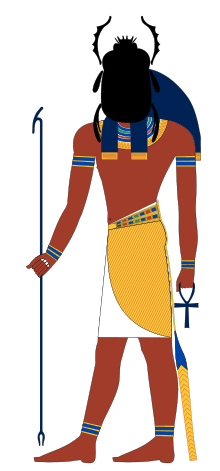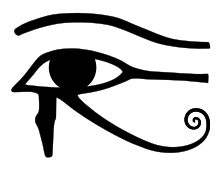Khepri
Khepri (Egyptian: ḫprj, also transliterated Khepera, Kheper, Khepra, Chepri) is a scarab-faced god in ancient Egyptian religion who represents the rising or morning sun. By extension, he can also represent creation and the renewal of life.
| Khepri | |||||
|---|---|---|---|---|---|
Rising sun | |||||
 Khepri is often represented as a scarab holding aloft the morning sun, or a scarab-headed man. | |||||
| Name in hieroglyphs | |||||
| Major cult center | Heliopolis | ||||
| Symbol | scarab, blue lotus | ||||
| Parents | Nut (some accounts) | ||||
| Offspring | All gods (some accounts), Ma’at | ||||
| Part of a series on |
| Ancient Egyptian religion |
|---|
 |
|
Beliefs |
|
Practices
|
|
Deities (list) |
|
Locations |
|
Symbols and objects
|
|
Related religions
|
|
|
Symbolism
Khepri ḫprj is derived from Egyptian language verb ḫpr, meaning "develop", "come into being", or "create".[1] The god was connected with the scarab beetle (ḫprr in Egyptian), because the scarab rolls balls of dung across the ground, an act that the Egyptians saw as a symbol of the forces that move the sun across the sky. Khepri was thus a solar deity. Young dung beetles, having been laid as eggs within the dung ball, emerge from it fully formed. Therefore, Khepri also represented creation and rebirth, and he was specifically connected with the rising sun and the mythical creation of the world.
Religion
There was no cult devoted to Khepri, and he was largely subordinate to the greater sun god Ra. Often, Khepri and another solar deity, Atum, were seen as aspects of Ra: Khepri was the morning sun, Ra was the midday sun, and Atum was the sun in the evening.[1]
Appearance
Khepri was principally depicted as a scarab beetle, though in some tomb paintings and funerary papyri he is represented as a human male with a scarab as a head, or as a scarab with a male human head emerging from the beetle's shell. He is also depicted as a scarab in a solar barque held aloft by Nun. The scarab amulets that the Egyptians used as jewelry and as seals represent Khepri.[2]
References
- Wilkinson, Richard H. (2003). The Complete Gods and Goddesses of Ancient Egypt. Thames & Hudson. pp. 230–233
- Hart, George (2005). The Routledge Dictionary of Egyptian Gods and Goddesses. Routledge. pp. 84–85
External links
![]()